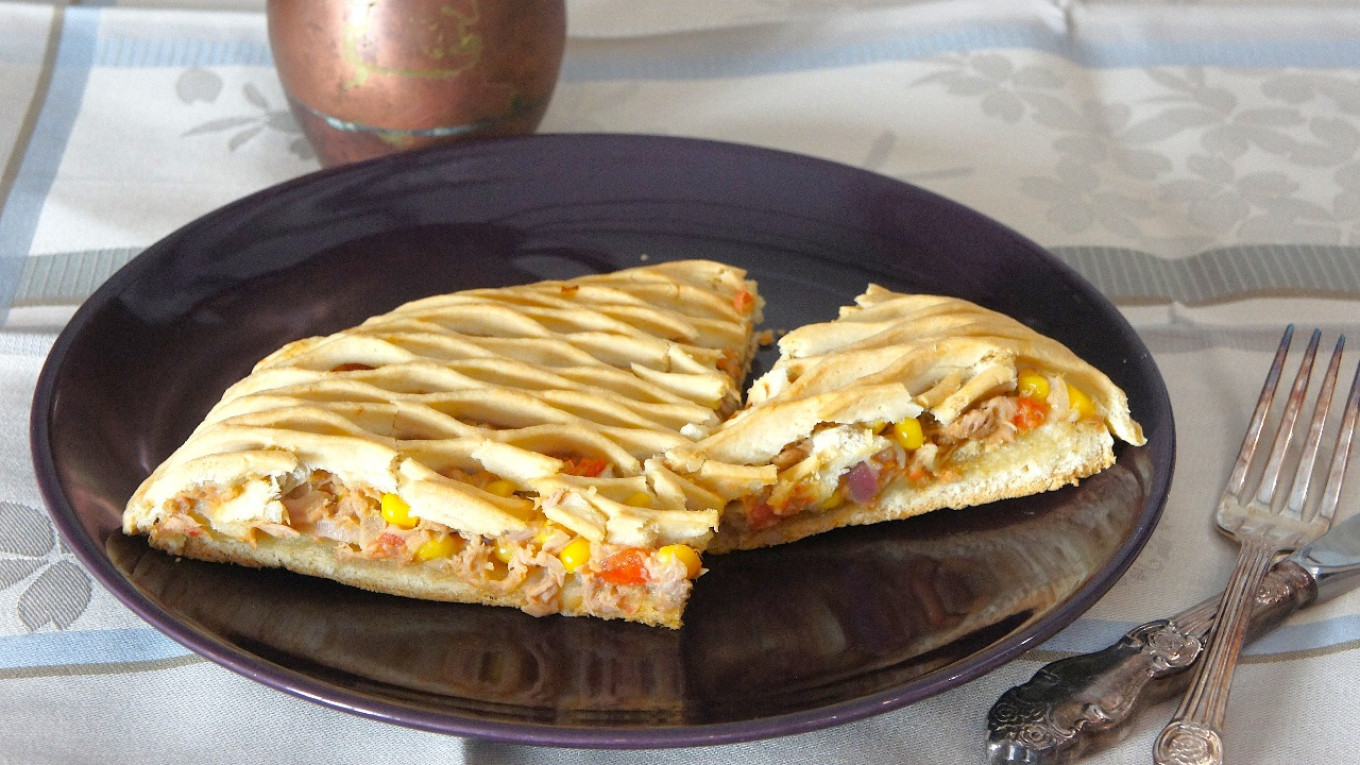Pirogi (pies) have always held a place of honor on the Russian table. Fish pies have come down to us from ancient times barely influenced by foreign culinary traditions, making them a truly national treasure. The variety of recipes and ingredients are vivid testimony to the richness of local cuisine.
Russia has always been famous for pies. Historically, they were made with sour dough — rye for day-to-day pies and wheat for holidays. They were placed on the bottom of the stove to bake, right on the brick base of the firebox. If the filling could leak out (for example, in fish pies), special clay pans were used.
The very origin of the word “pie” in Russian — пирог — is related to the word for “feast”— пир. So we can be certain that pies were festive dishes served to guests.
TPies were first mentioned in 12th century sources. But by the middle of the 16th century, “Domostroi” had recipes for a wide variety of pies: “we make pies on non-fasting days with meat or dairy fillings, with whatever is on hand, and on fasting days with grain or peas, or jam, or turnips, or different mushrooms, or cabbage, or with whatever God gives. And the whole family is happy.”
The housekeeping book of the Orthodox Church Patriarch for 1698 mentions a “pike body pie” as one of the dishes served to Patriarch Adrian. What is this wonderful dish? It is simply one of the variants of a dish called “telnoye,” which is described in detail in a book published in 1795 called “The Lenten Cook, or Preparation of Various Lenten Dishes.” Even today the recipe would be considered intricate: “Take a pike or pike perch, pull out its flesh, dice it finely. Then take another fish and and make it into a pie, fill it with the the flesh [from the first fish] that has been fried.” The author seems to have experimented with fillings, combining minced fish cooked in various ways.
There was a particularly impressive variety of pies for Lent in “Domostroi”:“sour pies with peas, big pies with poppy seeds and hemp oil with peas, a big pie with poppy seed milk, a big and succulent pie with viziga (dried sturgeon spinal cord — a delicacy); a pie with whitefish, a pie with catfish or with herring, a woven pie — and layer all the fillings with blinis.”
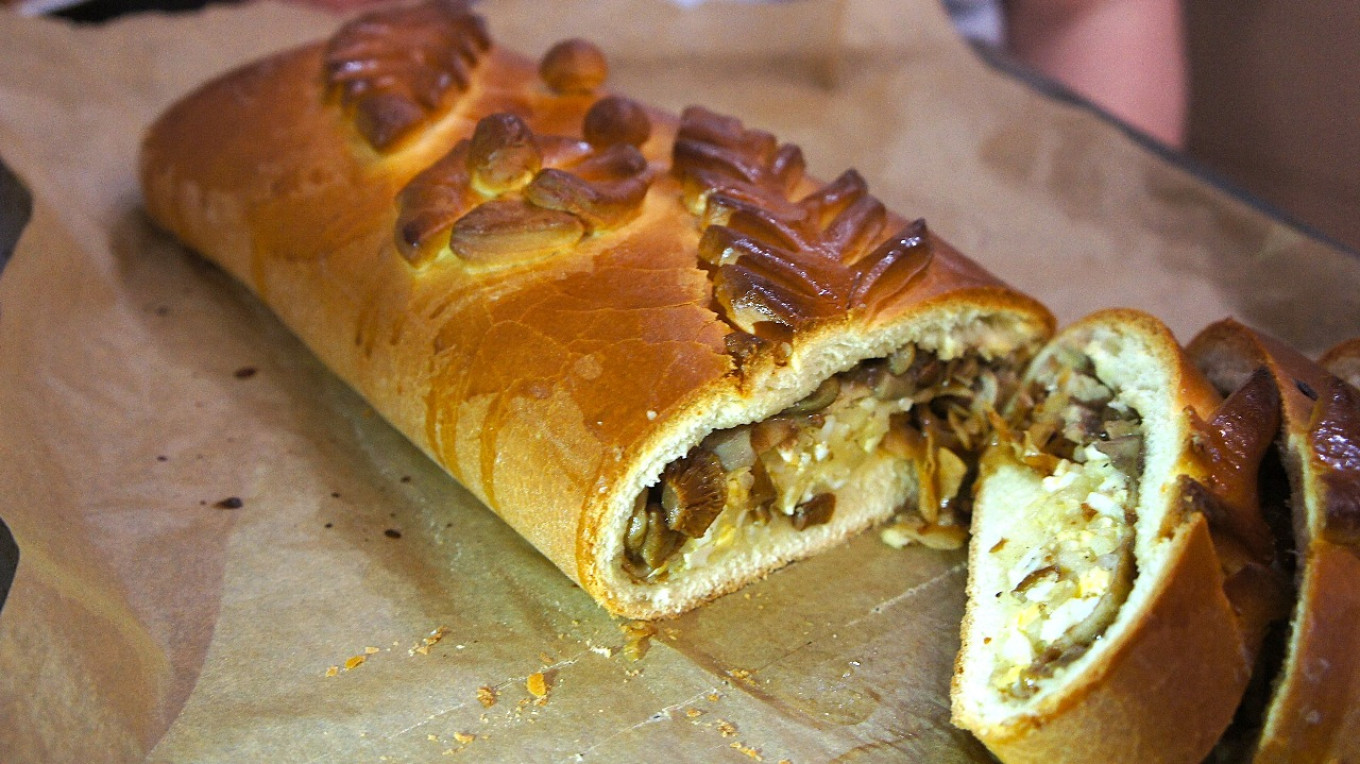
Layering the filling with blinis (crepes) is the signature of a more complex pie: kulebyaka. This pie appeared during the peak of the art of pie-making in Russia in the 19th century. The famous writer I. S. Shmelev left a vivid description of this type of pie. The “great kulebyaka made for the church holiday of the Annunciation was made with viziga and has different fillings in each of the four corners: mushrooms, salmon, burbot liver, and pikeperch caviar with rice.”
In the 19th century another famous fish pie called rastegai appeared. The famous Russian historian Mikhail Pilyaev (1842-1899) provides a curious history: “Rastegai pies became fashionable in Moscow in 1807, when the gypsy Stesha acted on the hearts and pockets of her listeners and admirers with her nightingale voice. She was particularly well-known for her rendition of the song ‘Sarafanchik-rasstegaichik’ (‘my sarafan with buttons’). In honor of the song, chefs began to bake rastegai (open-faced pies).”
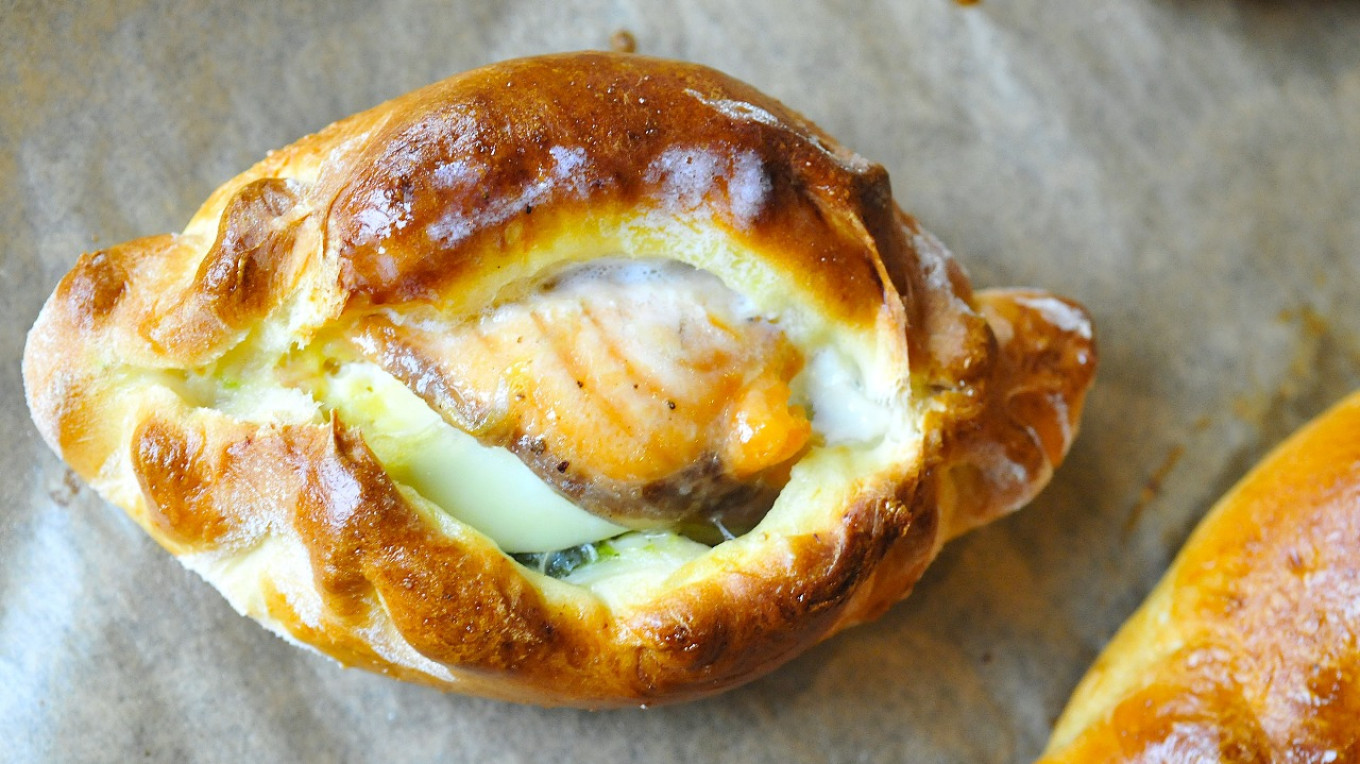
The Soviet period brought a new era in the history of fish pies. In the 1960s, pies made with canned fish such as salmon, saira and tuna became very popular homemade pies. But alas, they lost their somewhat “ceremonial” character. Instead of being a festive treat, these pies were just a simple family meal.
The dough for Russian pies was mainly based on rye sourdough starter, which “lived” in every house. How could a kitchen be without it? This is the basis of rye bread in Russia. Pies were always made with sourdough starter, which was called “live.” But sourdough starter wasn’t the only basis for dough. Home cooks also used sour milk, sour cream, beer, braga and whey. Using different sour products let cooks vary the taste of the pies.
The pie filling could anything that was cooked for lunch, except, of course, soup.
Pies could be filled with meat, fish, mushrooms, grains and/or eggs either separately or in various combinations depending on what was on hand and what products were in season. Of course, meat and fish fillings were mostly prepared for holidays. For weekdays, the pies were simpler.
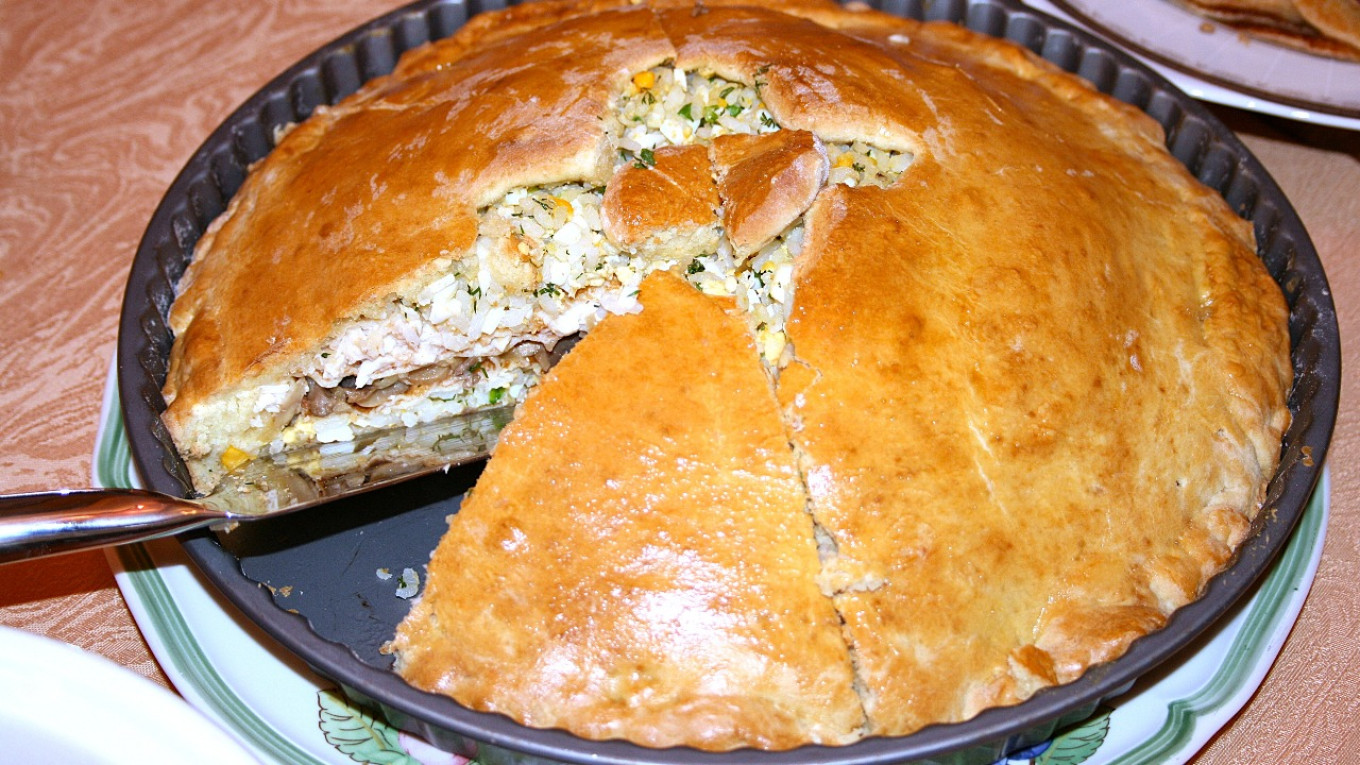
The idea of “wrapping” the usual lunch foods — such as cabbage, grains, mushrooms, fish or meat — in dough was very convenient for food “on the go,” that is, for someone to take to work in the field or go on a trip. That's when the saying “You can wrap everything in dough” was born. And truly, you can put just about anything in a pie. The pie became a full three-course meal in one.
In some provinces peasants baked pies every day with the simplest fillings, such as grains — millet, oatmeal, buckwheat or peas; with vegetables — cabbage, carrots, turnips or potatoes. Seasonal vegetables and herbs such as rhubarb, nettle, sorrel, field horsetail were added, which provided vitamins to help replenish health after a long winter.
The culinary history of fish pies in Russia is probably the most extensive, with good reason. People settled on the many banks of rivers and lakes, which provided both water and sustenance: fish. And since the food culture was based on regional ingredients, fish was the main foodstuff on the table. Fish pies are a national dish, a truly Russian pastry.
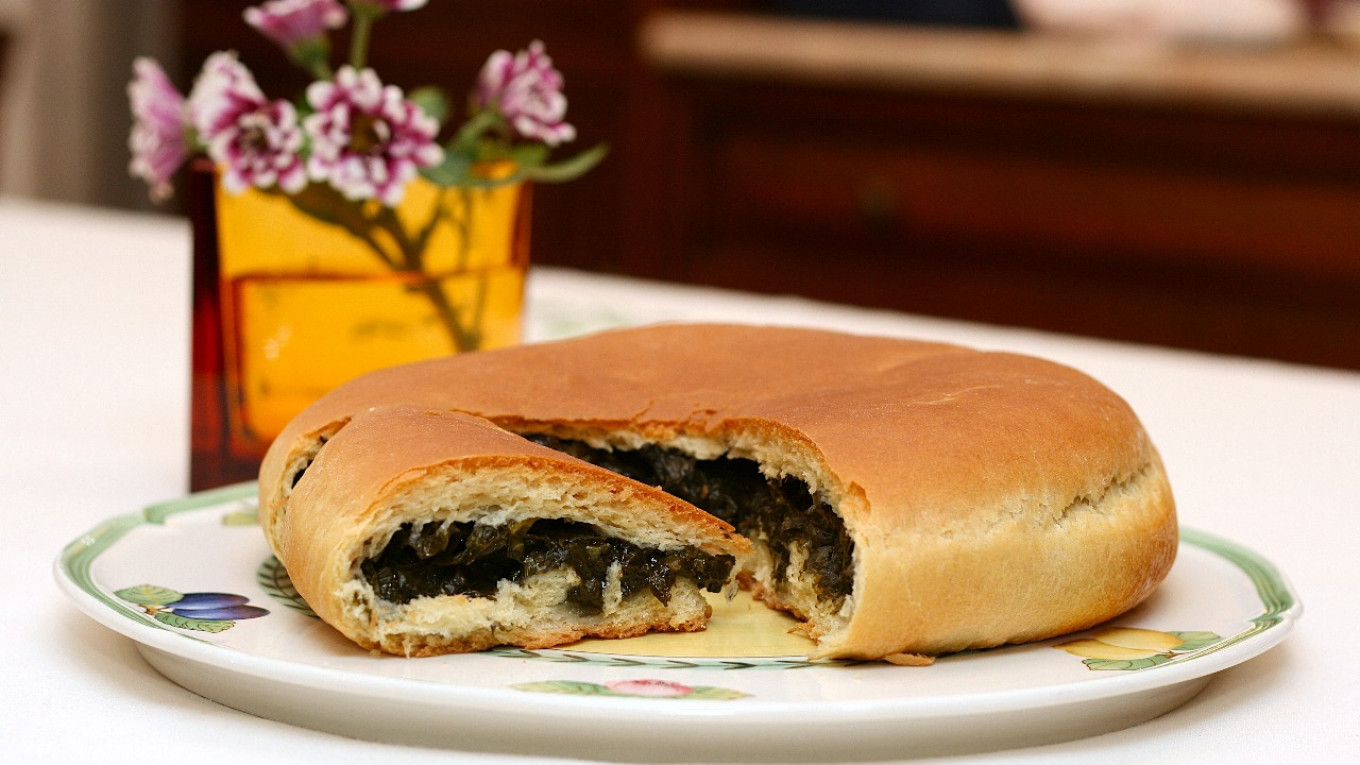
Fish pies were baked everywhere and are usually called рыбники (from the word for fish — рыба: fishniki). They could be pies made with large fish that were cut into pieces, usually without boning the fish first. Or they could be pies made with small fish, which would be put into the pies whole. Different varieties of fish were also mixed together. If the fish was big enough, they’d clean the fish and use it whole, without boning it. The pie was made in steps: first the fish was laid on the on the bottom layer of dough, then a layer of onions and thin slices of potatoes were placed on top. To prevent the pie from leaking during baking, the edges of the bottom layer were pulled up over the “filling” and sealed tightly, “crust on crust.” This was called “bending the pie.”
Fish pies were an obligatory dish on festive occasions, religious holidays, and sometimes even at funerals. The pies were decorated according to their purpose.
Fresh fish went into the pie straight from the closest water source. Smaller fish that were easily caught went into everyday open pies, or into closed ones if someone was traveling. On holidays and celebrations people usually baked richly decorated two-crusted pies made with rare fish.
Salted fish was just as good as fresh fish for fillings. Of course, only the affluent could afford some types of fish, and you couldn’t buy expensive sturgeon or salmon everywhere. It was easier to buy this fish salted and use it in pies for special occasions.
Over time, canned fish appeared in Russian gastronomy and turned out to be an excellent filling, along with fresh and salted. So another kind of fish pie appeared.
This pie is usually filled with canned fish along with rice or potatoes. Unlike traditional fish pies, here the dough can be made with anything: dry and pressed yeast, kefir, butter (puff pastry) or short crust pastry. This makes the pies faster and easier to prepare and adds a variety of flavors.
Tuna Pie
Makes 2 small pies
Ingredients
Dough
- 500 g (4 c) best quality wheat flour
- 200 g (1 c + 2 tsp) whole milk
- 45 g (1/3 c + 1 ½ tsp) sugar
- 35 g (2 ½ Tbsp) butter
- 1/2 egg (2 Tbsp of raw whisked egg)
- 7 g (1 tsp) salt
- 15 g pressed yeast (4 ½ tsp) or 5 g (1 2/3 tsp) dry yeast
- for the liaison (for basting dough): 1 egg and 2 Tbsp milk
Filling for 2 pies (300 g/10.5 oz per pie)
- 230 g (8 oz) canned tuna in its own juice (fillets, drained)
- 70 g (2.5 oz or 1/3 c) red onion, finely diced
- 100 g (3.5 oz or scant ½ c) diced tomatoes
- 100 g (3.5 oz or generous ½ c) canned corn
- 60 g (4 + 1 tsp) mayonnaise
- 30 g (1/4 c) best quality wheat flour
- salt, pepper to taste
Instructions
- Make the dough: Dissolve the yeast and sugar in the milk. Put the flour and salt in a mixing bowl, mix, pour in the yeast mixture, add the egg and knead the dough until smooth. At the end add the butter in several additions. Leave to rise for 90 minutes.
- While the dough is rising, prepare the filling. Mash the tuna with a fork, mix with the rest of the ingredients; salt and pepper to taste.
- To form the pies, divide the dough into 4 parts: 2 parts each weighing 250 g (about 8.8 oz) for the bottom of the pies and 2 parts weighing 125 g (about 4.5 oz) for the top of the pies. Flaten the mounds of dough and leave to rest for 7 minutes.
- For the bottom of the pies, roll out the dough into a circle 3-5 mm (1/8-1/4 inch) thick. Spread the filling evenly up to about 1.5 cm (scant inch) from the edge. Pull up the edge so that it covers part of the filling and press down lightly.
- For the top of the pies, roll out the dough into a circle approximately the diameter of the pie and cut a grid with a pastry cutter (or cut strips to make a grid). Place it on top of the filling, tucking the edges of the top under the bottom pie crust. Leave to proof for 40 minutes.
- Turn the oven on to 200°C /395°F.
- Prepare the liaison. Whisk the egg and milk with a fork. Baste the pie with the liaison before baking.
- Bake the pie for 30 minutes.
- Allow the pie to cool slightly before serving.

A Message from The Moscow Times:
Dear readers,
We are facing unprecedented challenges. Russia's Prosecutor General's Office has designated The Moscow Times as an "undesirable" organization, criminalizing our work and putting our staff at risk of prosecution. This follows our earlier unjust labeling as a "foreign agent."
These actions are direct attempts to silence independent journalism in Russia. The authorities claim our work "discredits the decisions of the Russian leadership." We see things differently: we strive to provide accurate, unbiased reporting on Russia.
We, the journalists of The Moscow Times, refuse to be silenced. But to continue our work, we need your help.
Your support, no matter how small, makes a world of difference. If you can, please support us monthly starting from just $2. It's quick to set up, and every contribution makes a significant impact.
By supporting The Moscow Times, you're defending open, independent journalism in the face of repression. Thank you for standing with us.
Remind me later.



